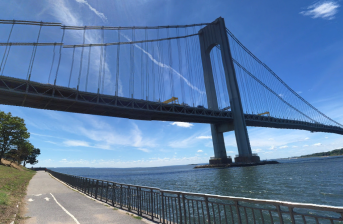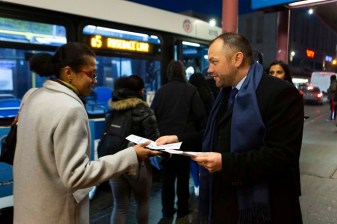The Link Between Bridge Toll Dysfunction and Unsafe Streets
Did “toll shopping” figure in the death last week of cyclist Kevin Lopez in Long Island City?

We don’t know for sure. But there’s a good chance it did, judging from a remark made by a passenger in the Mercedes that struck Lopez’s bicycle on Queens Plaza North near 29th Street around 2:15 p.m. on Tuesday, July 28, causing him to crash and die eight days later, in New York-Presbyterian/Weill Cornell Hospital.
Lopez, age 20, was bicycling to his home in Long Island City from classes at nearby LaGuardia Community College, where he was studying business administration, according to the Daily News. Press reports have Lopez cycling west on Queens Plaza North rather than on the adjacent Queensboro Bridge Greenway, perhaps preparatory to crossing Queens Boulevard. The Mercedes driver was apparently also westbound on Queens Plaza North where it feeds into the Queensboro Bridge when he struck Lopez’s bicycle from behind.
Immediately after the collision, the passenger, Shann Mon, 39, told DNAinfo that he and the driver were “heading back to Harlem after picking up medicine at a pharmacy.” Who knows if that’s true, let alone which pharmacy in Queens or where in Harlem. But from many parts of western Queens to most locations in Harlem, the Triboro Bridge appears to offer a quicker drive than the Queensboro.
For example, from 36th Avenue and Crescent Street, around 10 blocks from the crash location, to Adam Clayton Powell Jr. Boulevard and 129th Street, the QB route is longer by 1.9 miles and 5 minutes than the Triboro route, according to Google Maps queried for the same time and day of the week as the actual crash. The catch is that the Triboro route entails a $5.54 toll ($8.00 without E-ZPass), whereas the Queensboro is untolled. That free ride leads thousands of Queens-to-Manhattan drivers to divert each day to the QB from their “natural” path via the Triboro or the Queens Midtown Tunnel. Mon’s Mercedes-driving pal may have been one of them.
Toll shopping is as old as toll roads and bridges. But the incentive to detour to toll-free routes in the five boroughs has escalated as the MTA has raised tolls relentlessly on its bridges and tunnels — a process driven in part by the absence of tolls on most entrances to the Manhattan Central Business District.
Some gridlock-averse drivers opt for the relatively underutilized Brooklyn Battery and Queens Midtown Tunnels and the Triboro Bridge, but they are far outnumbered by toll-averse drivers. Chronic traffic congestion on the free East River bridges is the result.
The overflow traffic on the Queensboro, Williamsburg, Manhattan, and Brooklyn bridges isn’t confined to the spans. It spills onto the bridge approaches on either side of the East River — in Long Island City and East Midtown, in Downtown Brooklyn and Chinatown, in Williamsburg, Little Italy and the Lower East Side, snarling streets and putting pedestrians and bike riders in harm’s way.
Traffic engineer Sam Schwartz has argued for decades that balancing the city’s toll regime by tolling the East River bridges and 60th Street while lowering tolls on the MTA bridges could help curb traffic injuries and fatalities, especially to pedestrians and cyclists, by redistributing and lowering traffic volumes.
I recently modeled Sam’s hypothesis by grafting the citywide and localized traffic reductions projected by my BTA spreadsheet to 2014 NYC crash map data generated by staff at Sam Schwartz Engineering Co. Together, we concluded that extending the toll currently charged on the East River tunnels ($5.54 in each direction; $8.00 without E-ZPass) to the East River bridges and across 60th Street, as envisioned in the Move NY plan, would cut pedestrian and cyclist injuries throughout western Queens by an average of 9 percent, simply by lowering and re-assigning vehicle miles traveled. It stands to reason that the reductions in the immediate vicinity of the Queensboro Bridge — where Kevin Lopez was struck and killed — would be even greater.
Move NY-style toll reform turns out, then, to be a vital ingredient for the city’s Vision Zero initiative. Less VMT, not to mention less driver frustration, translates into fewer menacing vehicles and less menacing behavior. Ditto for Move NY’s billion or more dollars a year in net revenues that could help fund the MTA capital plan, allowing the authority to replace century-old signals and controls and boost train frequencies and draw trips from autos, yellow cabs, and Ubers.
Yet the Move NY Plan must navigate through — or around — Governor Andrew Cuomo’s indifference and, now, internecine warfare between Albany and City Hall. Curiously, the electeds who are all about saving lives from Legionnaires’ Disease are stunningly passive when it comes to structural reforms that could save lives on city streets.

